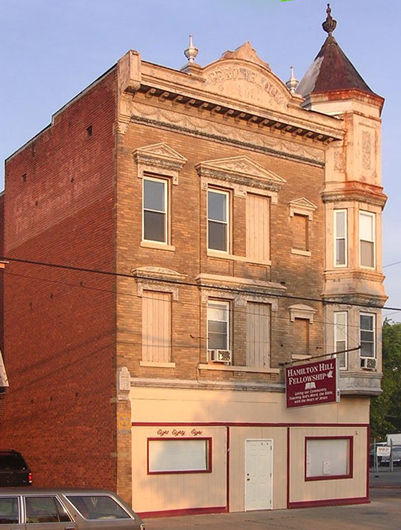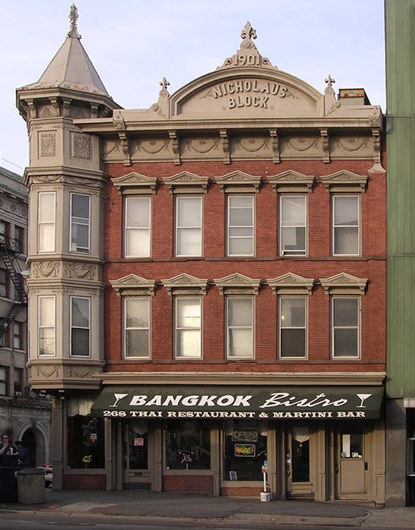|
BUSINESS
BLOCK
Each "business block" with its ornamental urns, crowned cornice, and owner's name on the facade, was the palace of a merchant prince, even if his kingdom was a hundred feet of sidewalk. Fairly few "blocks" actually ran corner-to-corner. More commonly they contained the owner's establishment plus one or two additional storefronts. If times were prosperous, the owner expanded into this extra space; when business slumped, the extra storefronts were rented along with the flats upstairs.
One hundred years later, every Main Street has a business block, often in jarring contrast with its modern neighbors. While today's chain retail buildings reflect the concepts of "branding", uniformity, and predictability - the faith that you'll find the same jeans at any GAP or that a Big Mac will always taste the same - the business block's idiosyncratic decoration advertised the individual personality of its owner and the uniqueness of his merchandise.
IMAGE AND ALL PHOTOS BY HOWARD OHLHOUS
|
|
| |

Schenectady circa 1950, looking west down State Street from Crescent Park
The Lorraine Block sign showed up in downtown Schenectady postcards for over sixty years. When the Lorraine was nearly new in 1906, Walkers' Pharmacy was in the main storefront and the photographic studio of Eugene Clare, the dental office of Elmo Getz, and the real estate-insurance-law offices of Albert and Horace Van Voast were among the businesses upstairs. Like many buildings in this scene, the Lorraine Block disappeared in the 1960s. Today the corner of State and Clinton is occupied by an undistinguished modern bank.
|
|
| |

The Pfeil Block, 888 Albany Street, Schenectady
The handsome late-Victorian Pfeil Block presents a mystery.
Henry Pfeil was the proprietor of "Henry's Cycle Shop", whose fading sign is still visible on the side wall. However, the Cycle Shop, which once sold Indian motorcycles, did not relocate to 888 Albany until the late 1920s. As the close up at the top of the page shows, the "Pfeil Block" plate has been brazed over an earlier name, leaving the ghostly outline of the word "BLOCK" as the only clue to the building's original identity.
|
|
| |

The Nicholaus Block, 266-268 State Street, Schenectady
When the Nicholaus Hotel opened in 1901, the Schenectady City Directory listed 50 hotels, approximately the same total as the number of practicing attorneys in the city. The hotel block, topped by fleur-d-lys and sporting a bay window-turret like the Pfeil Block, housed the German-cusine Nicholaus' Restaurant until 1975.
|
|
| |

Coplon Block,1326 State Street, Schenectady
Although the metal plaque at the roof peak reads "1928", the Coplon Block may be an older multi-family house converted to commercial use at that time. Here Jacob Coplon, an emigre from Russia, operated Coplon's Department Store through the depression and World War II years. The Coplon family lived over the store with tenants, who during the 1930s included a printer and a General Electric employee.
|
|
| |

The Seneca Block, 118-120 Jay Street, Schenectady
The elegant Seneca Block began as a hotel. In 1920, the Seneca offered its guests 47 rooms with mission style furnishings and two private bathrooms on each floor. It now has apartments upstairs and an Indo-Pacistani restaurant at street level.
|
|
| |
CLICK HERE TO RETURN TO THE "LOST LANDMARKS" HOME PAGE |
|

